Three-Dimensional Motion Compensation Method Based on Sparse Array Designed for Time-Division Multiplexing Multiple-Input-Multiple-Output Through-Wall Radar
Abstract
:1. Introduction
2. Signal Model
3. Motion Compensation Method
3.1. Reference-Channel Motion Compensation Algorithm
3.2. Proposed Motion Compensation Algorithm
4. Simulation and Experimental Data
4.1. Simulation Data
4.2. Experimental Data
5. Conclusions
Author Contributions
Funding
Institutional Review Board Statement
Informed Consent Statement
Data Availability Statement
Conflicts of Interest
References
- Xu, C.; Wu, Q. High-Resolution Through-the-Wall Radar Imaging with Exploitation of Target Structure. Appl. Sci. 2022, 12, 11684. [Google Scholar] [CrossRef]
- Hu, Z.; Zeng, Z.; Wang, K.; Feng, W.; Zhang, J.; Lu, Q.; Kang, X. Design and Analysis of a UWB MIMO Radar System with Miniaturized Vivaldi Antenna for Through-Wall Imaging. Remote Sens. 2019, 11, 1867. [Google Scholar] [CrossRef] [Green Version]
- Pan, J.; Ni, Z.-K.; Shi, C.; Zheng, Z.; Ye, S.; Fang, G. Motion Compensation Method Based on MFDF of Moving Target for UWB MIMO Through-Wall Radar System. IEEE Geosci. Remote Sens. Lett. 2022, 19, 3509205. [Google Scholar] [CrossRef]
- Song, Y.; Jin, T.; Dai, Y.; Zhou, X. Efficient Through-Wall Human Pose Reconstruction Using UWB MIMO Radar. IEEE Antennas Wirel. Propag. Lett. 2022, 21, 571–575. [Google Scholar] [CrossRef]
- Song, Y.; Jin, T.; Dai, Y.; Song, Y.; Zhou, X. Through-Wall Human Pose Reconstruction via UWB MIMO Radar and 3D CNN. Remote Sens. 2021, 13, 241. [Google Scholar] [CrossRef]
- Kim, G.W.; Lee, S.W.; Son, H.Y.; Choi, K.W. A Study on 3D Human Pose Estimation Using Through-Wall IR-UWB Radar and Transformer. IEEE Access 2023, 11, 15082–15095. [Google Scholar] [CrossRef]
- Jia, Y.; Guo, Y.; Chen, S.; Song, R.; Wang, G.; Zhong, X.; Yan, C.; Cui, G. Multipath Ghost and Side/Grating Lobe Suppression Based on Stacked Generative Adversarial Nets in MIMO Through-Wall Radar Imaging. IEEE Access 2019, 7, 143367–143380. [Google Scholar] [CrossRef]
- Randazzo, A.; Ponti, C.; Fedeli, A.; Estatico, C.; D’Atanasio, P.; Pastorino, M.; Schettini, G. A Through-the-Wall Imaging Approach Based on a TSVD/Variable-Exponent Lebesgue-Space Method. Remote Sens. 2021, 13, 2028. [Google Scholar] [CrossRef]
- Tan, K.; Chen, X. Precise Near-Range 3-D Image Reconstruction Based on MIMO Circular Synthetic Aperture Radar. IEEE Trans. Microw. Theory Tech. 2021, 69, 2651–2661. [Google Scholar] [CrossRef]
- Pan, J.; Ye, S.; Shi, C.; Yan, K.; Liu, X.; Ni, Z.; Yang, G.; Fang, G. 3D imaging of moving targets for ultrawideband MIMO throughwall radar system. IET Radar Sonar Navig. 2021, 15, 261–273. [Google Scholar] [CrossRef]
- Li, X.; Wang, X.; Yang, Q.; Fu, S. Signal Processing for TDM MIMO FMCW Millimeter-Wave Radar Sensors. IEEE Access 2021, 9, 167959–167971. [Google Scholar] [CrossRef]
- Hu, X.; Lu, M.; Li, Y.; Wang, Y. Motion Compensation for TDM MIMO Radar by Sparse Reconstruction. Electron. Lett. 2017, 53, 1604–1606. [Google Scholar] [CrossRef]
- Rambach, K.; Yang, B. Colocated MIMO Radar: Cramer-Rao Bound and Optimal Time Division Multiplexing for DOA Estimation of Moving Targets. In Proceedings of the 2013 IEEE International Conference on Acoustics, Speech and Signal Processing, Vancouver, BC, Canada, 26–31 May 2013. [Google Scholar]
- Kronauge, M.; Rohling, H. New Chirp Sequence Radar Waveform. IEEE Trans. Aerosp. Electron. Syst. 2014, 50, 2870–2877. [Google Scholar] [CrossRef]
- Warren, C.; Giannopoulos, A.; Giannakis, I. GprMax: Open Source Software to Simulate Electromagnetic Wave Propagation for Ground Penetrating Radar. Comput. Phys. Commun. 2016, 209, 163–170. [Google Scholar] [CrossRef] [Green Version]


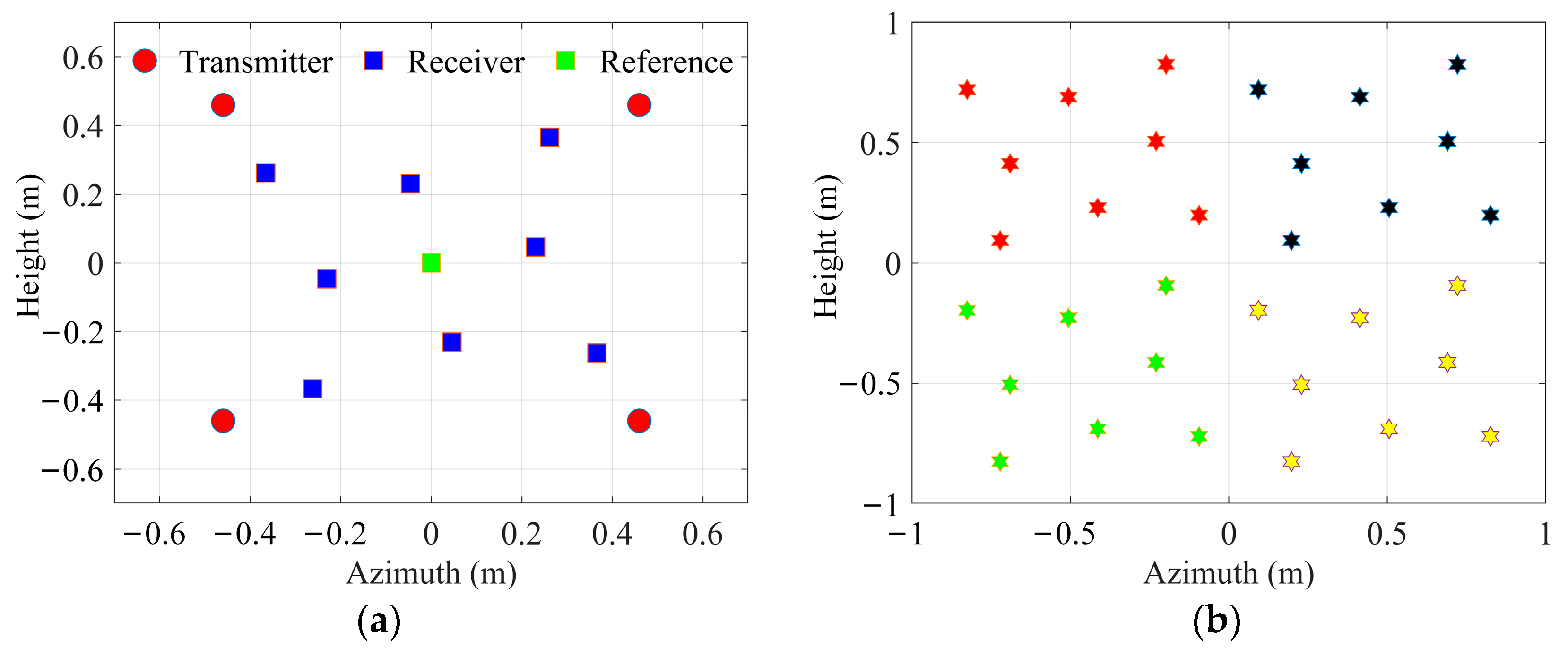

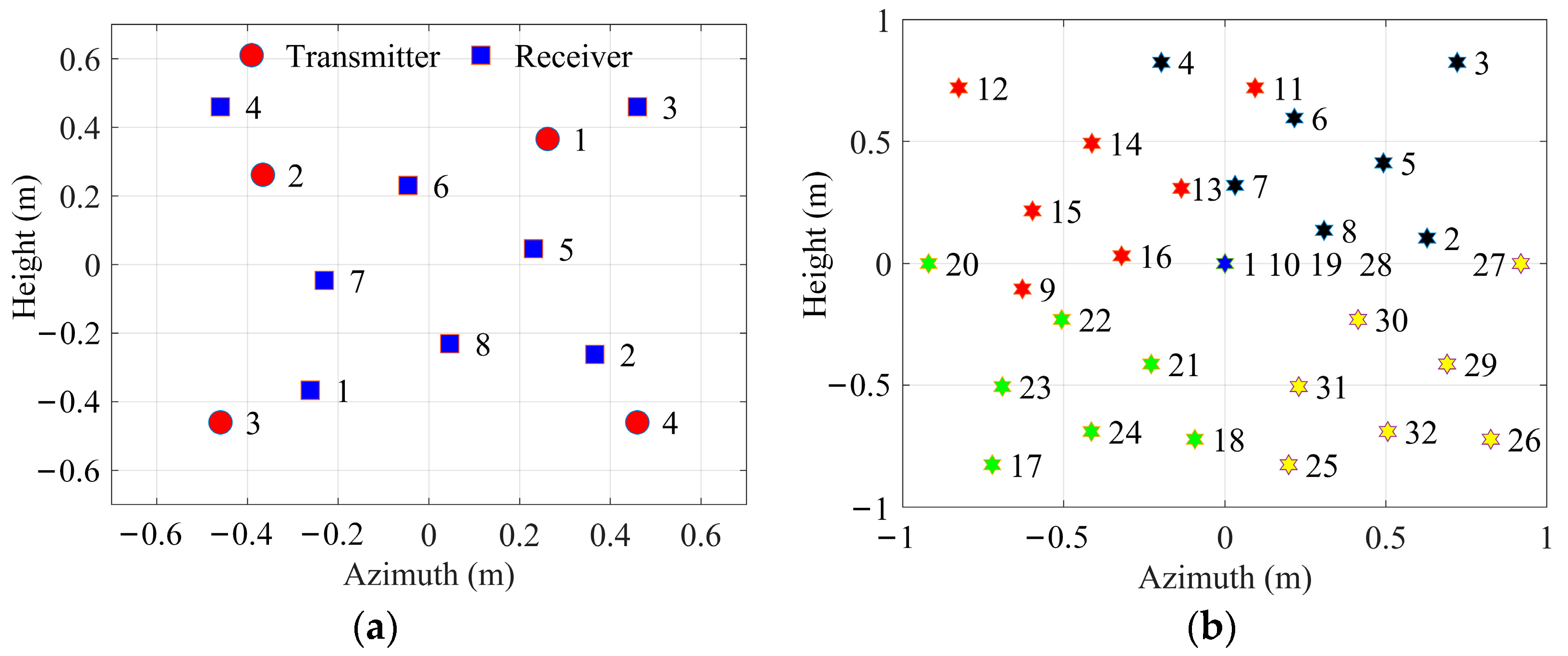
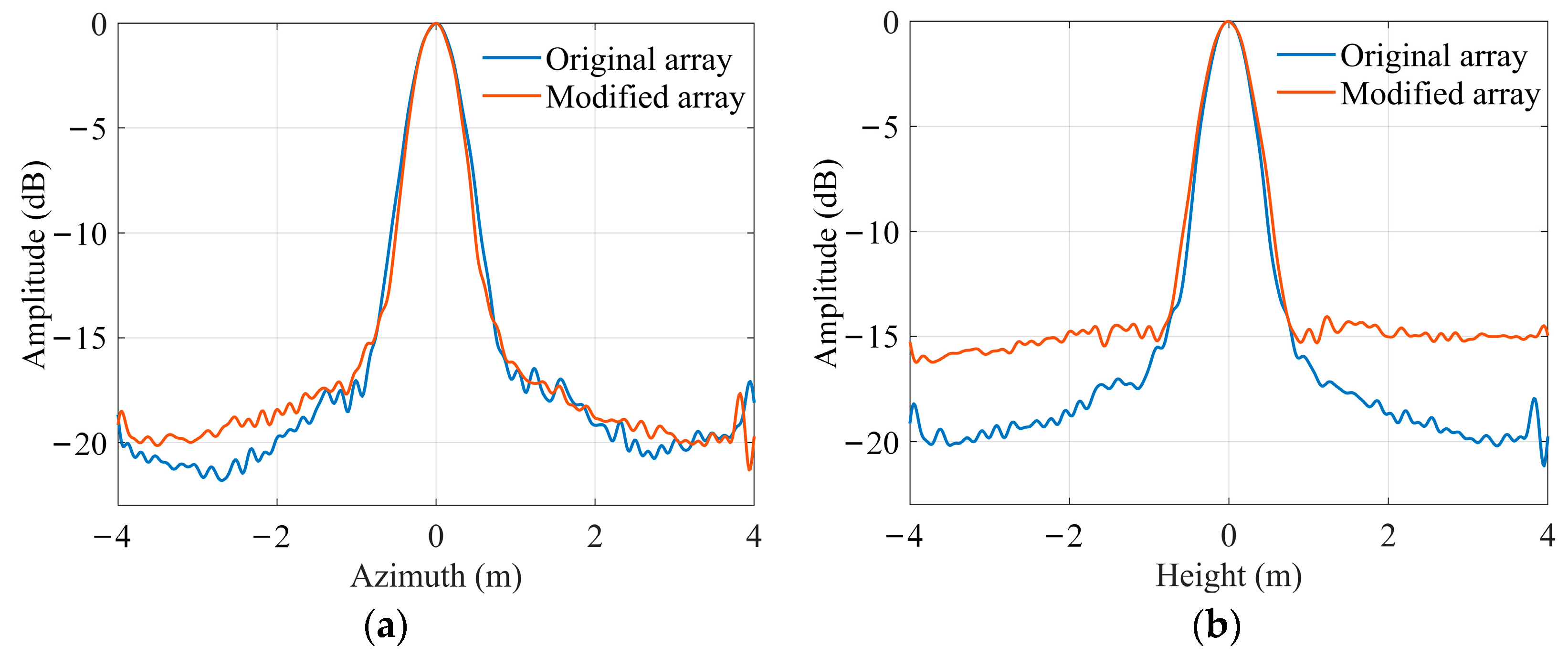





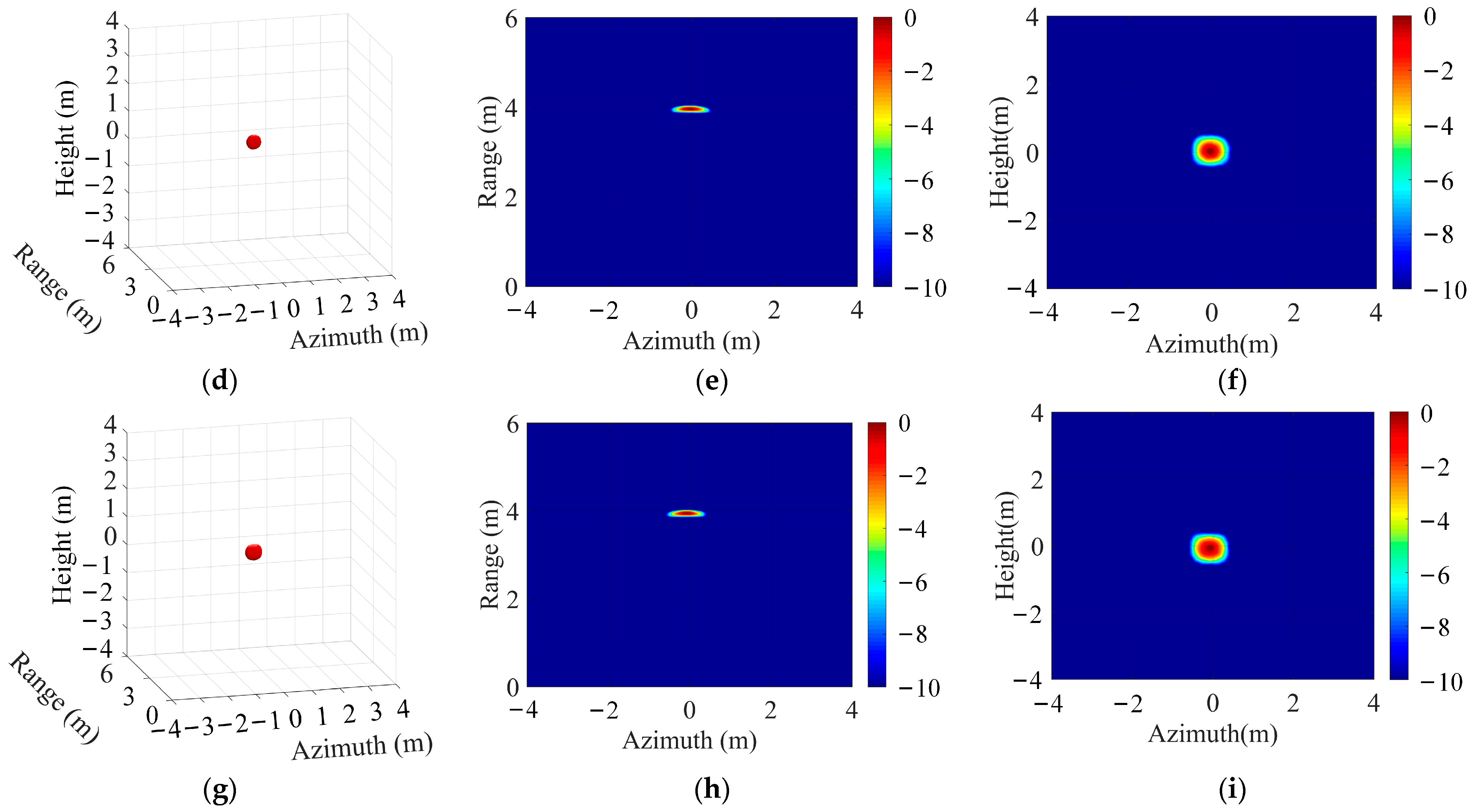

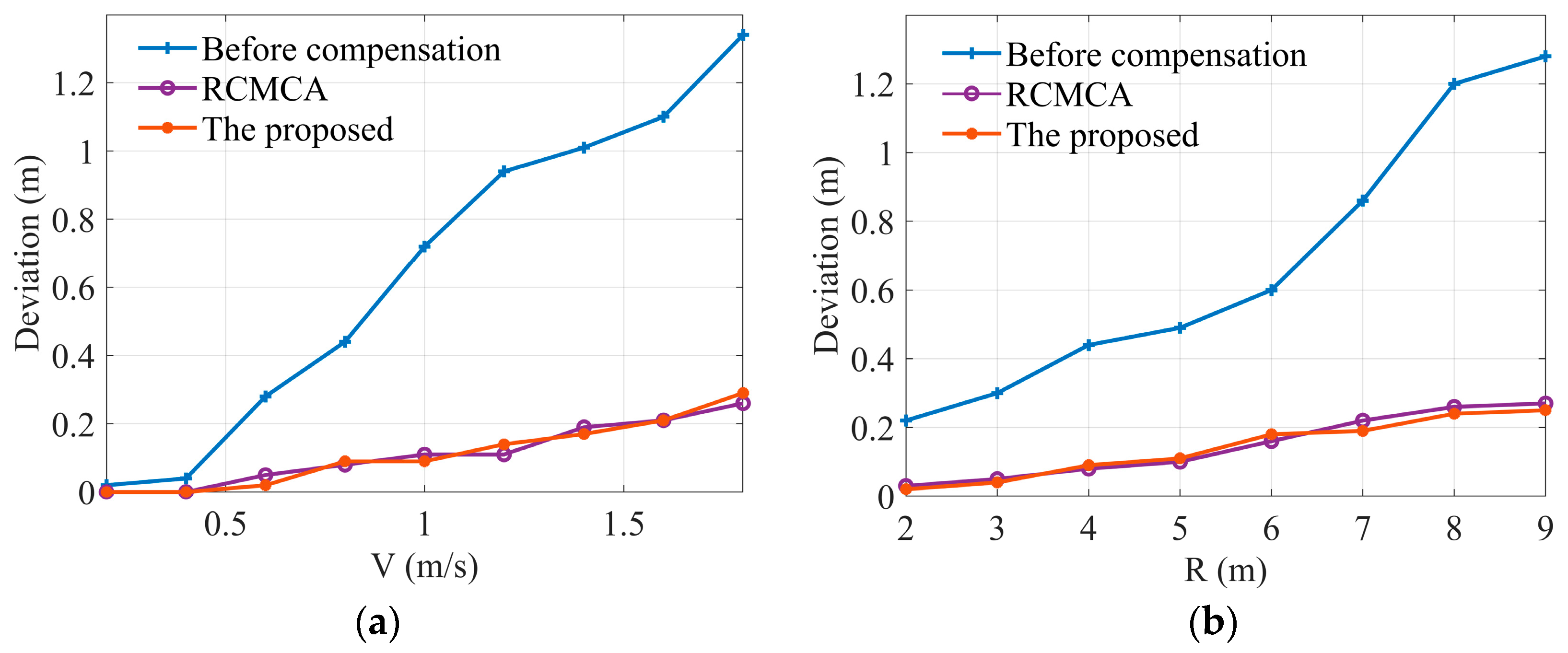


| Parameters | Value |
|---|---|
| Signal | Pulse |
| Center frequency | 1 GHz |
| Bandwidth | 1 GHz |
| Scanning rate | 3 frame/s |
| Performance | Sidelobes | Position Deviation | Imaging Time | System Complexity |
|---|---|---|---|---|
| Method | ||||
| Before compensation | −1.3 dB @azimuth −6.0 dB @height | <1.40 m | 0.25 s | low |
| RCMCA | no sidelobes | <0.30 m | 0.26 s | high |
| The proposed | no sidelobes | <0.30 m | 0.26 s | low |
| Parameters | Value |
|---|---|
| Signal | Pseudo-random encoded signal |
| Antenna | The Archimedes spiral antenna |
| Radiation angle | −60°–+60° |
| Center frequency | 1 GHz |
| Bandwidth | 1 GHz |
| Scanning rate | 3 frame/s |
| Speed | 0.3 m/s | 0.7 m/s | 1.1 m/s | 1.5 m/s |
|---|---|---|---|---|
| Method | ||||
| Before compensation | 0.02 m | 0.54 m | 1.04 m | 1.20 m |
| RCMCA | 0.00 m | 0.15 m | 0.18 m | 0.28 m |
| The proposed | 0.00 m | 0.16 m | 0.20 m | 0.28 m |
| Range | 2 m | 4 m | 6 m | 8 m |
|---|---|---|---|---|
| Method | ||||
| Before compensation | 0.25 m | 0.42 m | 0.60 m | 0.98 m |
| RCMCA | 0.05 m | 0.12 m | 0.17 m | 0.27 m |
| The proposed | 0.04 m | 0.12 m | 0.19 m | 0.26 m |
Disclaimer/Publisher’s Note: The statements, opinions and data contained in all publications are solely those of the individual author(s) and contributor(s) and not of MDPI and/or the editor(s). MDPI and/or the editor(s) disclaim responsibility for any injury to people or property resulting from any ideas, methods, instructions or products referred to in the content. |
© 2023 by the authors. Licensee MDPI, Basel, Switzerland. This article is an open access article distributed under the terms and conditions of the Creative Commons Attribution (CC BY) license (https://creativecommons.org/licenses/by/4.0/).
Share and Cite
Pan, J.; Liang, X.; Wu, S.; Zhao, D.; Yan, K.; Nie, J.; Hu, J.; Zhou, B.; Fang, G. Three-Dimensional Motion Compensation Method Based on Sparse Array Designed for Time-Division Multiplexing Multiple-Input-Multiple-Output Through-Wall Radar. Appl. Sci. 2023, 13, 8662. https://doi.org/10.3390/app13158662
Pan J, Liang X, Wu S, Zhao D, Yan K, Nie J, Hu J, Zhou B, Fang G. Three-Dimensional Motion Compensation Method Based on Sparse Array Designed for Time-Division Multiplexing Multiple-Input-Multiple-Output Through-Wall Radar. Applied Sciences. 2023; 13(15):8662. https://doi.org/10.3390/app13158662
Chicago/Turabian StylePan, Jun, Xiao Liang, Shiyou Wu, Di Zhao, Kun Yan, Jinliang Nie, Jianmin Hu, Bin Zhou, and Guangyou Fang. 2023. "Three-Dimensional Motion Compensation Method Based on Sparse Array Designed for Time-Division Multiplexing Multiple-Input-Multiple-Output Through-Wall Radar" Applied Sciences 13, no. 15: 8662. https://doi.org/10.3390/app13158662





